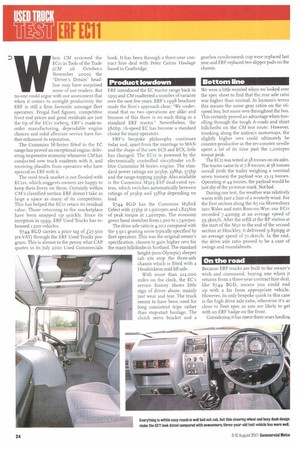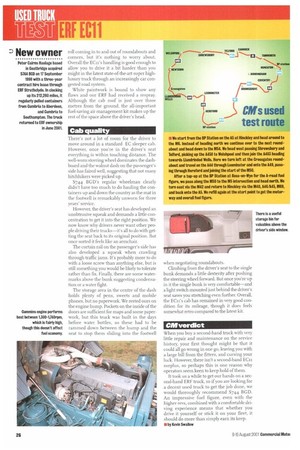ECti in Tools of the Trade (CM 26 October-1 November
Page 24

Page 25

Page 26

If you've noticed an error in this article please click here to report it so we can fix it.
2000) the "Driver's Dream" headline may have surprised some of our readers. But
no-one could argue with our assessment that when it comes to outright productivity the ERF is still a firm favourite amongst fleet operators. Frugal fuel figures, competitive front end prices and good residuals are just the tip of the ECH iceberg. ERF's made-toorder manufacturing, dependable engine choices and solid aftercare service have further enhanced its reputation.
The Cummins M-Series fitted to the EC range has proved an exceptional engine, delivering impressive economy whenever CM has conducted new truck roadtests with it, and receiving plaudits from operators who have specced an ERF with it.
The used truck market is not flooded with ECiis, which suggests owners are happy to keep their livery on them. Certainly within CM's classified section ERF doesn't take as large a space as many of its competitors. This has helped the ECU retain its residual value. Those returning to the marketplace have been snapped up quickly. Since its inception in 1999, ERF Used Trucks has rehoused 1,500 vehicles.
S744 BGD carries a price tag of L27,5oo (ex-VAT) through the ERF Used Trucks program. This is almost to the penny what CAP quotes in its July 2001 Used Commercials
book. It has been through a three-year contract hire deal with Peter Cairns Haulage based in Coatbridge.
Product lowdown
ERF introduced the EC tractor range back in 1993 and CM roadtested a number of variants over the next few years. ERF's 1998 brochure made the firm's approach clear: "We understand that no two operations are alike and because of this there is no such thing as a standard ERF tractor." Nevertheless, the 38ohp, 16 -speed EC has become a standard choice for many operators.
ERF's bespoke philosophy continues today and, apart from the marriage to MAN and the shape of the new ECS and ECX, little has changed. The ECtt is powered by the electronically controlled six-cylinder io.8litre Cummins M Series engine. The standard power ratings are 3o3hp, 338hp, 375hp and the range-topping 399hp. Also available is the Cummins M3o5 ESP dual-rated system, which switches automatically between ratings of 3o3hp and 338hp depending on load.
S744 BGD has the Cummins M38oE Celect with 375hp at 1,900rpm and 1,825Nm of peak torque at 1,200rpm. The economy green band stretches from 1,300 to 1,74orpm.
The drive axle ratio is 4.1o:1 compared with the 3.91:I gearing more typically specified by fleet operators. This was the original owner's specification, chosen to gain higher revs for the many hilldimbs in Scotland. The standard height (non-Olympic) sleeper cab sits atop the three-axle chassis which is fitted with a Hendrickson mid-lift axle.
With more than 212,000 miles on the clock, the EC's service history shows little sign of driver abuse, mainly just wear and tear. The truck seems to have been used for long consistent trips rather than stop-start haulage. The clutch servo bracket and a
gearbox synchromesh cup were replaced last year and ERF replaced two slipper pads on the chassis.
Bottom line
We were a little worried when we looked over the spec sheet to find that the rear axle ratio was higher than normal. In layman's terms this means the same gear ratios on the i6speed box, but more revs throughout the box. This certainly proved an advantage when travelling through the tough A-roads and short hillclimbs on the CM test route. However, trunking along the nation's motorways, the slightly higher revs could ultimately be counter-productive as the rev-counter needle spent a lot of its time past the 1,200rpm torque peak.
The ECti was tested at 38 tonnes on six axles. The tractor came in at 7.8 tonnes; at 38 tonnes overall (with the trailer weighing a nominal seven tonnes) the payload was 23.13 tonnes. Operating at 44 tonnes, the payload would be just shy of the 30-tonne mark. Not bad.
During our test, the weather was relatively warm with just a hint of a westerly wind. For the first section along the A5 via Shrewsbury into Wales and onto Ross-on-Wye, our ECri recorded 7.42mpg at an average speed of 59.3km/h. After the refill at the BP station at the start of the M5o to the end of the second section at Hinckley, it delivered 9.85mpg at an average speed of 71Am/h. In the end, the drive axle ratio proved to be a case of swings and roundabouts.
On the road
Because ERF trucks are built to the owner's wish and command, buying one when it returns from a three-year contract hire deal, like S744 BGD, means you could end up with a far from appropriate vehicle. However, its only bespoke quirk in this case is the high drive axle ratio, otherwise it's as close to fleet spec as you are likely to get with an ERF badge on the front.
Considering it has spent three years hauling tainers from Southamp via Cumbria to rdeen, the dr iveline us to have coped well. eleration on the flat is fairly sharp thanks to higher gearing, which meant less work for us iugh the Welsh section a brisk eight-minute on the long windy vl up Dolfor Hill. At one it S744 BCD bravely Lured up into 8L, which Ate a feat for this stretch ;lad.
he Eaton i6-speed gearis the four-over-four with a splitter on the : and the range change he front. Unfortunately, .e are no lights on the to tell you what split or le you are in—that's left the driver's intuition. ? off gear is 3H on the flat but, on a slight inc or worse, 2 H is advisable. From then t's into 4H and then up into the higher ;e. For A-road action 40mph in 8H is ind 42,00rpm—right on peak torque.
he sweet spot for our FCti was between 0-1,740rpm, which does seem a little by today's standards—though it cerly didn't hurt its overall performance. At iph the Mil ticks over at 1,500rpni. For ige and power the truck holds the pace ty well on faster sections of the road, but truck is plated for and capable of 44le operations. The extra six tonnes could change that perception.
n the road you do experience some slight roll coming in to and out of roundabouts and corners, but it's nothing to worry about Overall the ECir's handling is good enough to allow you to drive it a bit harder than you might in the latest state-of-the-art super highluxury truck through an increasingly car congested road system.
White paintwork is bound to show any flaws and our ERE had received a respray. Although the cab roof is just over three metres from the ground, the all-important fuel-saving air management kit makes up the rest of the space above the driver's head.
Cab quality
There's not a lot of room for the driver to move around in a standard EC sleeper cab. However, once you're in the driver's seat everything is within touching distance. The well-worn steering wheel dominates the dashboard and the walnut dash on the passenger's side has faired well, suggesting that not many hitchhikers were picked up.
S744 BCD's regular wheelman clearly didn't have too much to do hauling the containers up and down the country as the mat in the footwell is remarkably unworn for three years' service.
However, the driver's seat has developed an unobtrusive squeak and demands a little concentration to get it into the right position. We now know why drivers never want other people driving their trucks—it's all to do with getting the seat back to its original position. But once sorted it feels like an armchair.
The curtain rail on the passenger's side has also developed a squeak when crawling through traffic jams. It's probably more to do with a loose screw than anything else, but is still something you would be likely to tolerate rather than fix. Finally, there are some watermarks above the bunk suggesting condensation or a water fight.
The storage area in the centre of the dash holds plenty of pens, sweets and mobile phones, but no paperwork. We rested ours on the engine hump. Pockets on the inside of the doors are sufficient for maps and some paperwork, but this truck was built in the days before water bottles, so these had to be rammed down between the hump and the seat to stop them sliding into the footwell when negotiating roundabouts.
Climbing from the driver's seat to the single bunk demands a little dexterity after pushing the steering wheel forward. But once you're up in it the single bunk is very comfortable—and a light switch mounted just behind the driver's seat saves you stretching even further. Overall, the FCri's cab has remained in very good condition for its mileage, though it does feels somewhat retro compared to the latest kit.
CM verdict
When you buy a second-hand truck with very little repair and maintenance on the service history, your first thought might be that it could all go wrong in one go, leaving you with a large bill from the fitters, and cursing your luck. However, there isn't a second-hand ECH surplus, so perhaps this is one reason why operators seem keen to keep hold of them.
It took us awhile to get our hands on a second-hand ERE truck, so if you are looking for a decent used truck to get the job done, we would thoroughly recommend S744 13GD. An impressive fuel figure, even with the higher revs, combined with a comfortable driving experience means that whether you drive it yourself or stick it on your fleet, it should do more than simply earn its keep. Eby Kevin Swallow




























































































































